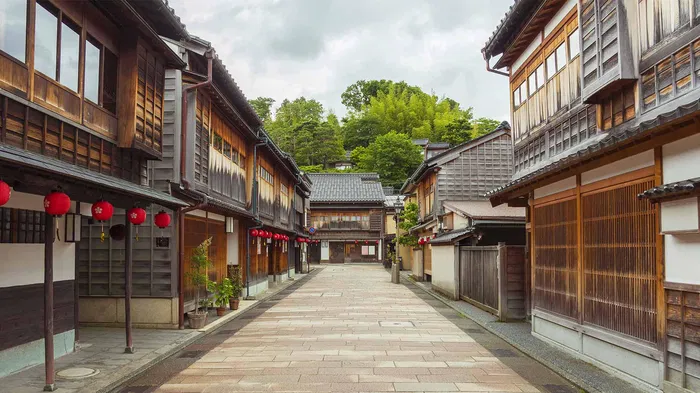Japan is famous all over the world for its cuisine, and what makes this country special (gastronomically talking) is the biodiversity of ingredients that every season brings with it.
During spring months, farmer's markets and supermarket shelves start selling a special tuber with a strange shape and texture called the nagaimo yam; have you ever heard of it?
A type of Japanese mountain yam, the kanji translation of the name "nagaimo" gives this perfect description:
長 ー なが ー naga ー long
芋 ー いも ー imo ー potato
Nagaimo is an elongated, cylindrical tuber with a rough, light brown skin and whitish pulp, popular in Japanese cuisine for its sticky texture.
Nagaimo gets sticky when grated, crunchy when fried, and if you grate and heat it, it becomes soft.
Cultivated mainly in the north of the country, particularly in Aomori prefecture, this Japanese mountain yam is a tuber that is in season twice a year. Planted in May, nagaimo is harvested partially in early autumn before the snow arrives, and then again in early spring after the snow has melted.
The result is two harvests of the same tuber with very different qualities. While the potatoes harvested in fall are fresh and mild in flavor, the spring ones are sweeter and riper.
What is Nagaimo Good For?
What makes this Japanese ingredient unique is its incredible versatility and special properties. Generally speaking, potatoes must be cooked before being eaten because the starch contained in them is not easily digestible. For this reason, it needs to be heated to prevent stomach pains.
However, potatoes of the yam family (together with another variety called yamaimo) can be eaten raw, and the reason is that they contain a lot of amylases, a digestive enzyme capable of breaking down starch to make it digestible.
It is therefore an ingredient that can be cooked in different ways, capable of taking on various flavors and textures. Nagaimo gets sticky when grated, crunchy when fried, and if you grate and heat it, it becomes soft.
Nagaimo Recipes: How to Cook Japanese Mountain Yam 3 Different Ways
If you're wondering how do you use nagaimo, here are three recipes that will introduce you to the different textures of this Japanese mountain potato.
- Neba Neba (Sticky) Tororo Soba
- Fuwa Fuwa (Soft) Nagaimo Pancake
- Saku Saku (Crunchy) Teriyaki Nagaimo
1. Neba Neba (Sticky) Tororo Soba
A perfect way to experience the neba neba (ネバネバ - “sticky”) texture of nagaimo is through the tororo (grated) version, served over a steaming bowl of soba noodles.
Simple to prepare and rich in nutritional properties, tororo soba is often enriched with egg yolk in the center and some thinly sliced negi.
It can be eaten hot or cold, and is considered a refreshing meal to defend against the heat of the Japanese summer.
Ingredients
- 300g buckwheat noodles (dried)
- 1/2 Japanese mountain yam (240g)
Dipping Sauce
- 25g of dried bonito shavings
- 1/2 cup soy sauce
- 1/2 cup mirin
- 1/2 teaspoon salt
- 6 cups water
- 4-5 scallions
Toppings
- Wasabi paste
- Salt
- Raw egg yolk
How to Cook Tororo Soba
Let's start with the dipping sauce. Put 6 cups of water in a pot and bring to boil over high heat. Add the dry bonito and bring the flame to medium intensity. Add 1/2 cup each of soy sauce and mirin, simmer for 2 to 3 minutes, and strain the soup through a strainer to catch the bonito flakes. Return the soup to the pot and heat over medium heat.
Bring a separate large pot of water to a boil and add the soba noodles, cooking until firm (check the cooking time on the packaging). When ready, drain the soba noodles through a colander and rinse the noodles under running water to remove any sliminess.
Grate the nagaimo and set it aside.
With the soup simmering over medium heat, add the soba noodles and cook for about a minute, adding a pinch of salt to taste.
Serve the soba noodle soup in a bowl, topped with grated nagaimo, red yolk in the center, and garnished with negi.
(Instead of soba, you can also enjoy the neba neba texture of mountain yam over rice!)
2. Fuwa Fuwa (Soft) Nagaimo Pancake
Here is the fuwa fuwa (ふわふわ - “soft” or “fluffy”) version of our nagaimo. These savory pancakes are a true treat for the palate, thanks to their mild flavor and fluffy texture.
Nagaimo pancake is a popular dish in Japanese pubs (izakaya) that’s also pretty easy to make! You just need to stir together grated nagaimo, egg, flour, mentsuyu (or just soy sauce is also ok!), and dashi stock; then cook it in a frying pan.
I recommend eating them freshly made and still warm, so you can taste all the flavors at their best.
Ingredients
- 300g Japanese mountain yam
- 1 egg
- 2 tbsp Flour
- 1 tbsp Mentsuyu
- 2 tbsp Sesame oil
- 1/2 tsp Salt
How to Cook Nagaimo Pancake
Peel and grate the yam, and combine with 1 egg, 2 tablespoons flour, 1 tablespoon mentsuyu, and 1/2 tsp of salt.
Heat sesame oil in a frying pan over medium-high heat, pour in the mixture of grated mountain yam, and cook for 3-4 minutes. Turn over when browned, cover, and steam over low heat for another 3-4 minutes.
Once ready, you can top it with your favorite ingredients (negi, bonito flakes, etc.).
3. Saku Saku (Crunchy) Teriyaki Nagaimo
Last but not least, the saku saku (さくさく - “crunchy”) nagaimo recipe. And what better version than one based on the popular teriyaki sauce?
A staple flavor of Japanese gastronomy, this thick sauce is based on a ratio of four simple ingredients: 2 parts soy sauce: 2 parts sake: 2 parts mirin: 1 part sugar.
Teriyaki gives a sweet and sour flavor that delicately embraces the various ingredients over which it’s glazed.
Ingredients
- 180g Japanese nagaimo
- 1 tablespoon salad oil
Seasoning
- 2 tbsp sake
- 1 tbsp sugar
- 2 tbsp soy sauce
- 2 tbsp mirin
Topping
- Green onion (chopped)
How to Cook Teriyaki Nagaimo
Peel the nagaimo yam and cut it into 1 cm thick slices.
Mix the ingredients for the seasoning in a separate bowl.
Heat salad oil in a frying pan over medium and add the nagaimo slices. Cook them slowly, flipping them to brown the other side. Once ready and light brown on both sides, add the bowl of seasoning and simmer. Turn the slices to coat both sides.
Serve and eat warm with sliced negi as a garnish.
These are just a few of the most popular recipes for cooking nagaimo. Whether you love soft, crispy, or slimy textures, this ingredient will satisfy your tastes.
Did you know...
- Nagaimo is a nutritional food high in potassium, that regulates the water balance in the body, together with a slimy substance that protects the mucous membrane of the stomach.
- Once peeled, the bright color of the nagaimo will change. If you want to preserve the color, you can peel it thickly with a knife or peeler so that no trace of the root's skin remains. After peeling, soak the yam in vinegar water for about 10 minutes to remove the acrid smell and prevent it from oxidizing and becoming discolored.
- The skin of the nagaimo yam contains a lot of polyphenols and beta-carotene and can be eaten. However, the exterior of the root is slightly hairy, which might be bothersome. To prep it for recipes, you can burn off these hairs using the fire from your gas stove.
- How long does nagaimo last in the fridge? You can keep it in the vegetable crisper drawer for up to a month, but it is best used within 2 weeks.
Check out these online Japanese cooking classes to learn more about Japanese home cooking with hands-on lessons!
 Tokyo
Tokyo Osaka
Osaka Kyoto
Kyoto Hyogo
Hyogo Hokkaido
Hokkaido Nara
Nara Fukuoka
Fukuoka Hiroshima
Hiroshima Kanagawa
Kanagawa Ishikawa
Ishikawa Florence
Florence Paris
Paris Rome
Rome Porto
Porto Barcelona
Barcelona New York
New York Venice
Venice Madrid
Madrid Marrakesh
Marrakesh Istanbul
Istanbul